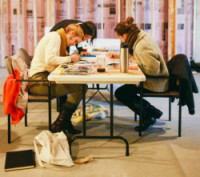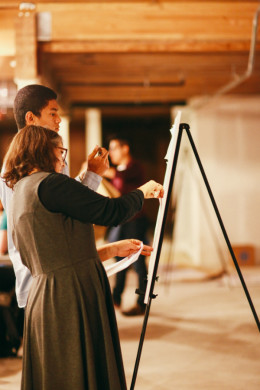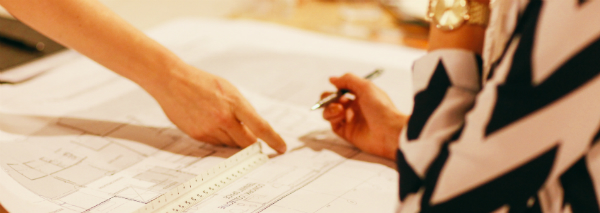Participating in an IIDA Student Charette is a rewarding experience that will prepare Interior Design students for real-world working conditions.
Content by Sarah Weber, IIDA Oregon Chapter – President, and Elsa Long, IIDA Oregon Chapter – Â VP Communications. Photos by Kaitlin Emmerling Photography. Â Â
The charette process is a chance to learn essential skills that are highly valued by employers, appreciated by colleagues, and offered as design services to clients. In order to maximize your participation in the charette, the IIDA West Coast Chapters* recommend the following practices:
 Create a Timeline: Time is of the essence, your team will have a mere 5.5 hours to complete your problem! Take time after you review the problem, structure and deliverables, to map out how long you should spend on each phase of the design. Think about the charette process as an accelerated schedule for a real-world problem, that only includes concept, schematic and design development phases. Talk about how long that your team is going to commit to a certain level of development at each phase. Be sure to leave time to regularly check-in and collaborate with each other; this is a great way to ensure that your overall design goals are achieved and cohesive. Also consider how long it will take to prepare your visual and verbal presentation; outline the content and who will be telling what parts of the story.
Create a Timeline: Time is of the essence, your team will have a mere 5.5 hours to complete your problem! Take time after you review the problem, structure and deliverables, to map out how long you should spend on each phase of the design. Think about the charette process as an accelerated schedule for a real-world problem, that only includes concept, schematic and design development phases. Talk about how long that your team is going to commit to a certain level of development at each phase. Be sure to leave time to regularly check-in and collaborate with each other; this is a great way to ensure that your overall design goals are achieved and cohesive. Also consider how long it will take to prepare your visual and verbal presentation; outline the content and who will be telling what parts of the story.
 Evaluate Strengths and Areas of Interest:
Evaluate Strengths and Areas of Interest:
Share what you believe your strengths are and how you see them contributing to the success of the end goal. Also convey any areas of interest that you may have so that your team can benefit from you research and expertise.
Examples may include daylighting, applied research, technology integration, advanced sustainability practices, etc.
Identify Individual Scopes:
Based on your discussion about strengths and areas of interest, evaluate the list of deliverables together and assign tasks accordingly. In the profession it takes a variety of individual skill sets to achieve the end result. Each team members role is vital to the success of a project; there is no unimportant job.
 Working Together:
Working Together:
The responsibility of the group is to facilitate contribution from each team member. This is in the team’s best interest in regards to content production and in presenting a collaboratively developed cohesive concept. Value each idea, but be willing to move on from ideas that don’t fit. Â Each idea builds upon another, allowing for the best idea to surface and evolve.
Communication is key to collaboration and a professionally successful process. As much as you contribute to the conversation, also be an attentive listener to your teammates. Ask clarifying questions when you don’t understand and resist the urge to interrupt. Strike a balance between humility and confidence when sharing your ideas and listening to others. As you check-in with each other regarding your progress and process, be sure to provide and accept constructive criticism.
Successful Presentation:
A successful presentation will communicate WHY you designed what you did, in addition to HOW you did it. WHY was that your concept? WHY do believe that your design will improve the end-user’s experience? WHY tells a story, HOW tells a process.
 Identify what the purpose of your design is. Revisit your team’s initial design goals and evaluate how they might have evolved as the project developed. This will help you to identify what the end goals and concepts were, how your design achieved them and how it informs the story of your design.
Identify what the purpose of your design is. Revisit your team’s initial design goals and evaluate how they might have evolved as the project developed. This will help you to identify what the end goals and concepts were, how your design achieved them and how it informs the story of your design.- Consider telling the story of the how the end-user will interact with the environment and how the design improves that experience. In what ways can your team personalize the story of your design so that it is successfully conveyed to your audience?
- Edit your story. Identify what exactly it is that you want to communicate and be intentional about your vocabulary. Consider what you want the jurors to take away about the design.
Whether this is your first charette or hundredth, this exercise is sure to be challenging and invigorating. We hope that you find these suggestions helpful for working as a group. Any Interior Design professional will tell you that the skills learned and demonstrated in a charette will directly apply to your professional career.
We have every confidence that you will be successful in your collaborative efforts and look forward to seeing your design solutions!
If you want to use these tips in a real-life charette, register now for the February 21st IIDA Oregon Chapter Student Charette. The winner will advance to the West Coast Design Charette on April 11, 2015 in Los Angeles, Calif., which will feature the winning teams from all four West Coast IIDA Chapters.  The winning West Coast Regional team will go on to the International IIDA Student Design Charette at NeoCon 2015 in Chicago.
*IIDA West Coast Chapters include: Oregon, Northern Pacific, Northern California and Southern California Chapters

